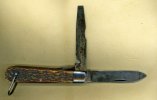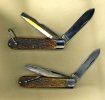I am not sure I understood your question, but I will take a stab at it;
The reason they switched to steel liners & bolsters was that most of the brass was going to other military applications. Steel was more abundant & stronger than brass, so they used steel for the bolsters & liners.
There are certain applications where brass performs far better than steel, such as in shell casings. They made the liners & bolsters from steel or iron, thus saving a large amount of brass for rifle cartridges.
Hope this helps,
Dale
EDIT:
Tom said the seller was wrong on some of his facts, not all.
Finding a knife of mid 20th century manufacture, with steel liners & bolsters is generally inductive of manufacture during WWII.
Brass was used in artillery shell casings & rifle cartridge casings. Brass is an alloy of copper and zinc; both also have other war time uses. Copper is used widely in communication & for electrical wire. Zinc is used to prevent corrosion of steel and also in batteries.
Nickel silver is an alloy of copper & nickel and sometimes also contains zinc. Nickel also has wartime applications. It is used for plating, and used extensive in steel, including tool steel such as D-2.
From this it is easy to see that the US government would limit the use & availability of brass & nickel silver for knife manufacture, as they had far more critical use for brass, copper, nickel & zinc.
A folding knife could just as easily be made of all steel, except the handle, and still function perfectly, even though decades later (long after the war was over) they are prone to rusting.


